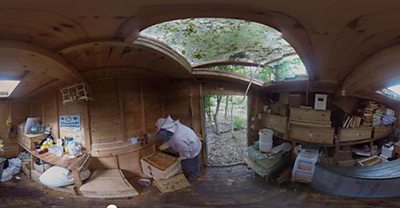
±«Óătv R&D are interested in 360 degree live-action experiences, focusing on the journalism and documentary applications, craft and value to ±«Óătv audiences.
360 degree video allows the viewer to see in any direction around the camera, either with an onscreen navigating tool or with a head-mounted display such as the or . This is an exciting new medium in a broadcasting context, and very little research has been done to explore this area.
360 video brings new opportunities for memorable storytelling, immersing audiences into stories in a way that the traditional format cannot, but it also comes with its own challenges.
We have identified a series of studies running in parallel to focus on the different aspects of 360 live-action experiences, such as editorial guidelines, directorial guidelines, design and user experience. Our studies will further our understanding of these and provide guidance for the development of future 360 degree content.
In this study, the same 360 content were was viewed across three different platforms: a Gear VR headset, a smartphone and a laptop. (In the laptop condition, videos were non-interactive; the whole central 25% of the 360 image was displayed from left to right across the screento approximate a regular 16:9 image).A one minute clip of â a 360 presenter-led tour inside China Town â was used to orientate the user on each platform:
Inside Londonâs China Town, created by ±«Óătv R&D, ±«Óătv NewsLabs and Middlesex University
The main test stimulus material was , viewed immediately after the China Town clip. The Resistance of Honey is a character-led narrative about an urban beekeeper who makes music as well as honey from his bees. The team observed userâsâ behaviours and collected general comments whilst they watched the content. After users experienced each viewing scenario they were interviewed and asked to fill out a questionnaire. We were particularly interested in what users liked and disliked about the different viewing scenarios, how users explored the 360 space, and how users compared their experiences to watching traditional media.
The Resistance of Honey, commissioned by ±«Óătv R&D
The key findings from the study are as follows:
1. PresenceWhen viewing the content on a Gear VR, users commonlysome users described feeling like they were âthereâ and feeling closer to the content. One user said: âThere was the feeling of it not being a film youâre watching but an experience youâre having.â Some users expressed frustration at not being able to have more involvement in the scenes or talk to the characters. In comparison, users felt more removed from the content when viewing it on a laptop or smartphone.
2. Smartphone interactivityThere are two ways to âlook aroundâ a 360 degree video on a smartphone: physically moving the phone around in your hands, or swiping a finger across the touchscreen. Userâs preferences for these varied. Moving the phone â whilst being novel and interesting â was a tiring way to watch content and often caused unwanted movements. Using the touchscreen was more instinctive, however it caused problems for users who double tapped the screen and accidentally paused or jumped to different points in the video. Some users were frustrated by the limited interactivity, for example not being able to zoom.
3. AttentionViewing content on a Gear VR minimises distractions from the real world as, unlike a laptop or smartphone, it almost fills a userâs field of view and allows them to focus most of their attention on the video. However, the opportunity to look around all 360 degrees meant users were sometimes confused about where to look, or worried that they might miss something interesting when looking somewhere else.
4. ExplorationUsers were interested in the 360 degree video surroundings and excited to explore, both in the Gear VR and on the smartphone. However, this often led to users not concentrating on the information they were hearing, as they were so distracted by looking at the environment and not the speaker. Users were more likely to pay attention to what was said in the reporter-led narrative (China Town clip) compared to the character-led narrative (The Resistance of Honey) â though this may have been related to the speakerâs âdroningâ voice. These findings are : Users feel less free to explore the surroundings if they feel as though they have to focus on the reporter.
5. Screen sizeUsers felt that the screen was too small when viewing content on a smartphone, and that this made it difficult to see enough detail. This was not a problem when viewing content in the Gear VR, despite this headset also using an equal sized smartphone screen for its display. Indeed, the screen is a lot closer to your eyes in the Gear VR, almost filling your field of view, which may be why you feel like you are seeing more or noticing more details.
- -
- More on Virtual Reality and 360 Video:
- from day